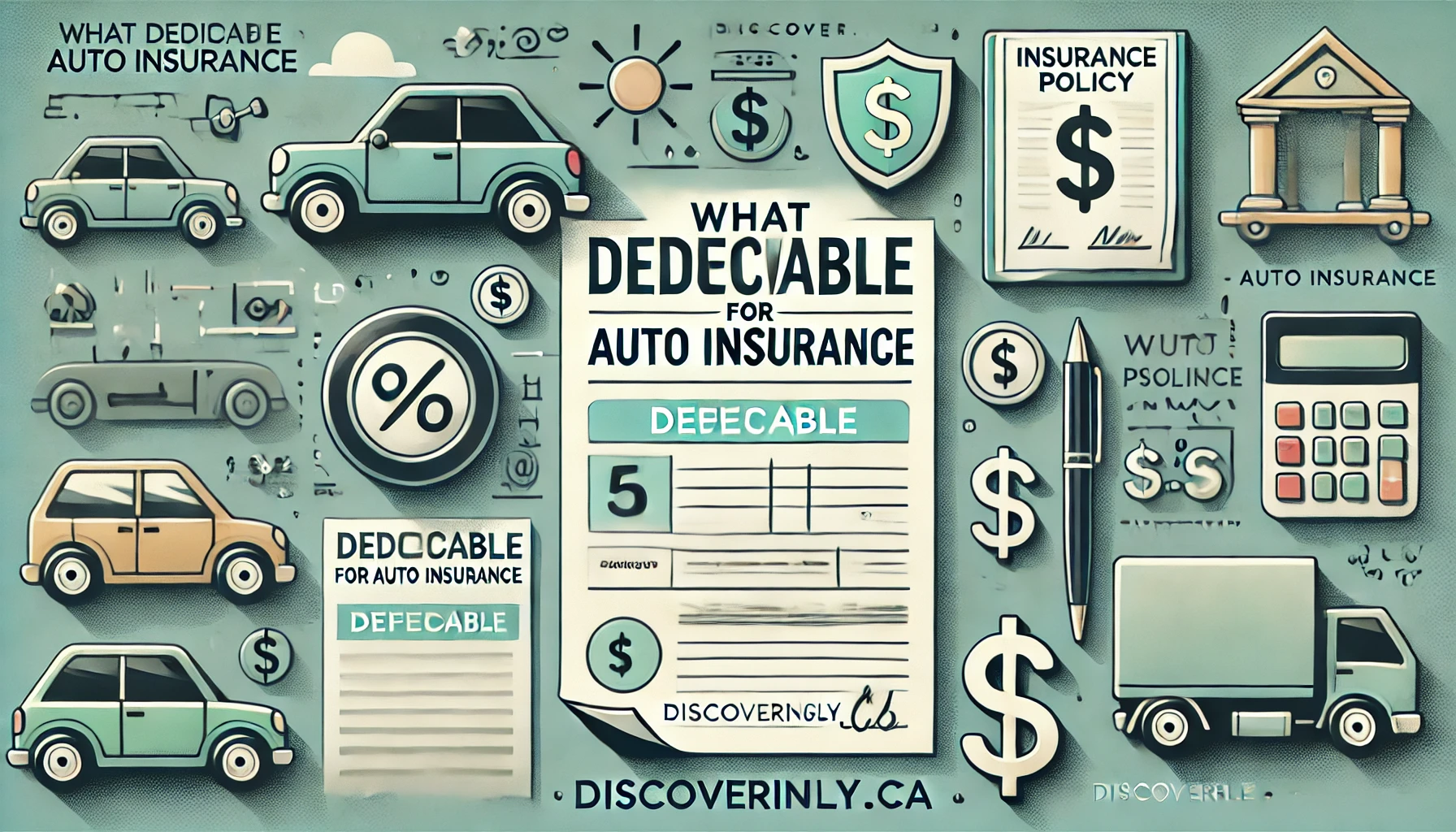Understanding Deductibles for Auto Insurance: A Discoveringly Guide
When it comes to auto insurance, knowing your way around terms like deductibles is essential. A deductible is the amount you pay out of pocket before your insurance kicks in to cover the rest, and choosing the right deductible can impact your insurance costs significantly. At Discoveringly, we’re here to help you make the best decisions for your wallet, your car, and your peace of mind. Let’s dive into what deductibles mean, how they work, and how you can choose the right one for your lifestyle.
1. What Exactly Is a Deductible?
A deductible is a set amount you agree to pay toward repairs or replacement when you file a claim. Think of it as your share of the cost, with your insurer covering the rest. For example, if you have a $500 deductible and experience $2,000 worth of damage, you’d pay the first $500, and your insurance company would cover the remaining $1,500.
So why do deductibles exist? Deductibles help keep insurance premiums manageable by ensuring that policyholders share a small portion of the cost. It also means you’re less likely to file small claims, which helps keep everyone’s insurance costs lower.
2. Different Types of Auto Insurance Deductibles
When it comes to car insurance, deductibles aren’t one-size-fits-all. Your policy might include a few different deductible types depending on what’s covered:
- Collision Deductible: Applies to damages from a collision with another vehicle or object, regardless of fault.
- Comprehensive Deductible: Covers incidents like theft, fire, vandalism, and natural disasters.
- Uninsured Motorist Deductible: Applies if you’re in an accident with someone who has little or no insurance coverage. Not all policies have this, but it can be invaluable if it’s an option.
3. High Deductible vs. Low Deductible: What’s the Difference?
Choosing between a high or low deductible boils down to balancing your monthly premium costs and how much you’re willing to pay out-of-pocket after an accident. Here’s how the choices compare:
- Higher Deductible, Lower Premiums: Going for a higher deductible generally means you’ll save on monthly premiums. You’ll pay more out-of-pocket in a claim, but this option can be a good fit if you’re a safe driver or don’t anticipate many claims.
- Lower Deductible, Higher Premiums: A lower deductible means your insurance will cover more in a claim, but your monthly premiums will likely be higher. If you prefer paying a little more each month to minimize the out-of-pocket cost after an accident, a lower deductible may be the right choice.
4. Choosing the Right Deductible for You
Everyone’s needs and driving habits are different, so choosing the right deductible is personal. Here are some key factors to think about:
- Your Financial Cushion: A high deductible might mean lower monthly costs, but make sure you can cover that amount if you need to make a claim. If $1,000 is doable for you, it could save you money on premiums.
- Driving Habits and Claim History: If you’ve had several claims or drive in high-traffic areas, a lower deductible can provide more peace of mind. Safer drivers who make fewer claims might benefit from a higher deductible.
- Vehicle’s Value: If you’re driving an older car, it might make more sense to have a higher deductible since repairs may not be as costly compared to the value of the car.
5. When Are Deductibles Applied?
Not every claim calls for a deductible. Here’s a quick rundown of when you’ll need to pay:
- Collision Claims: If you’re in an accident that requires collision repair, your deductible will likely apply.
- Comprehensive Claims: Incidents like theft, vandalism, and weather damage fall under comprehensive coverage, so you’d pay your deductible for these as well.
- Not-At-Fault Accidents: If the other driver is at fault, their insurance should cover the cost, meaning you usually don’t need to pay your deductible. If your insurance covers it first, you might pay initially but could be reimbursed later.
- Small Repairs: If repair costs are below your deductible, you’ll likely cover these expenses out-of-pocket without needing to file a claim.
6. High vs. Low Deductibles: Pros and Cons
Let’s break down the benefits and drawbacks of each option to help you weigh what’s best for you.
- High Deductible Pros:
- Lower monthly premiums, saving you money over time.
- Discourages minor claims, which can keep your insurance record cleaner and premiums stable.
- High Deductible Cons:
- You’ll pay more out of pocket after an accident, which could be challenging if unexpected.
- Low Deductible Pros:
- Lower costs when you make a claim, offering peace of mind if an accident occurs.
- Reduces financial strain if you need frequent repairs.
- Low Deductible Cons:
- Higher premiums, which add up over time, especially if you rarely make claims.
7. How to Adjust Your Deductible
Most insurance companies let you adjust your deductible either at renewal or at the start of a new policy. If your situation changes, or if you’re shopping for a better rate, reach out to your insurance provider to explore your options.
8. Special Considerations for Different Types of Drivers
Your lifestyle, driving experience, and vehicle type can all play a role in choosing your deductible.
- Young Drivers: Since younger drivers often face higher premiums, a moderate deductible can keep costs reasonable while still managing risk.
- Frequent Drivers: If you drive a lot or commute in heavy traffic, a lower deductible may offer more security.
- Occasional Drivers: If you rarely drive, a higher deductible can save on premiums, as there’s less risk of frequent claims.
9. Top Tips for Saving on Deductibles and Premiums
- Build an Emergency Fund: Setting aside funds can make it easier to handle a high deductible if you ever need to.
- Bundle Policies: Many insurers offer discounts if you bundle auto insurance with home or renters insurance.
- Use Discount Programs: Safe driving programs or loyalty discounts may help reduce overall costs, giving you more flexibility with your deductible.
10. Discoveringly’s FAQ Section
Q: Can I change my deductible after I file a claim?
A: Deductibles apply for each term, so changes usually only go into effect when you renew or start a new policy.
Q: Should I choose a high deductible if I’m leasing my car?
A: Leasing companies may have requirements, so check first. Often, a lower deductible is preferred to avoid high costs if you have an accident.
Q: Is there an “average” deductible most people choose?
A: A $500 deductible is a common choice as it balances out monthly premiums with manageable out-of-pocket costs for most people.
Choosing the right deductible for your auto insurance policy is all about finding the balance that works best for your budget, driving habits, and comfort level. At Discoveringly, we know how crucial it is to get the right coverage without overpaying, so we’re here to guide you in making informed decisions. Remember, a well-chosen deductible can bring you one step closer to driving with confidence and peace of mind.






